|
|
让孩子爱不释手的历届超萌奥运吉祥物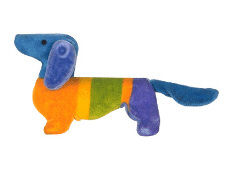 Waldi - Munich 1972 Waldi - Munich 1972Waldi - Munich 1972 "Waldi", the first official mascot to appear for the 1972 Munich Games, was a Dachshund. He was modelled after Cherie von Birkenhof, a longhaired breed of the species. Waldi was the first official Olympic mascot. "Waldi's" head and tail are light blue, and his body has vertical stripes with at least three of the five Olympic colours. Waldi was produced in various forms and sizes: plush, plastic, stickers, posters and buttons - but not as a pin until many years later. 1972年慕尼黑奥运会的吉祥物沃尔蒂是只惹人喜爱的腊肠狗,它是奥运会历史上第一个官方吉祥物。它的身体上交织着奥运的色彩,深受人们喜爱。以沃尔蒂的模样出现的奥运周边产品数不胜数。  Amik - Montreal 1976 Amik - Montreal 1976Amik - Montreal 1976 "Amik" the beaver was chosen as the official mascot for the Summer Olympic Games of Montreal, 1976. "Amik" in Indian language means beaver. The beaver has always been associated with hard work. 阿米克,1976年蒙特利尔奥运会官方吉祥物。这只海狸通常被看作是勤劳的标志。 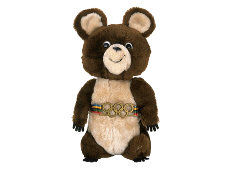 Misha - Moscow 1980 Misha - Moscow 1980Misha - Moscow 1980 The Moscow Olympic bear "Misha" was developed by the renowned illustrator of children's books Victor Chizikov. It took the illustrator six months to draw one hundred variations of the bear that also carried the full name Mikhail Potapych Toptygin. "Misha" was finally unveiled on December 19th, 1977. Misha was featured on hundreds of different pins, as a plush toy, in plastic, porcelain, rubber, wood, glass and metal. Misha also appeared on a stamp. 米沙是1980年莫斯科奥运会吉祥物。这只由俄国一位著名儿童文学家呕心沥血创造的俄国熊,于1977年12月19日呈现在公众面前。除了被做成各种产品,米沙还出现在了专门发行的邮票上。 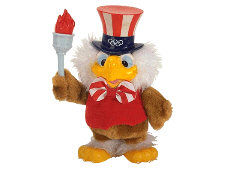 Sam - Los Angeles 1984 Sam - Los Angeles 1984Sam - Los Angeles 1984 The eagle "Sam" became the mascot of the Los Angeles Games. He was chosen because the imposing bald eagle is the national symbol of the United States. Robert Moore and his associates from Walt Disney Productions selected the eagle, and "Sam's" design was targeted to appeal to children. 山姆,1984年洛杉矶奥运会吉祥物。作为美国的国家象征,这只雄鹰理所当然的获此殊荣。迪士尼公司的罗伯特·莫尔创造了山姆,为的是激发孩子们的兴趣。 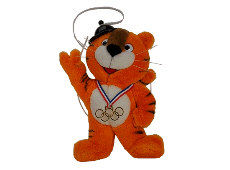 Hodori - Seoul 1988 Hodori - Seoul 1988Hodori - Seoul 1988 "Hodori", the mascot of the 1988 Olympic Games in Seoul, South Korea, portrays the friendly side of a tiger, which is present in many Korean legends. The mascot's name was chosen from a list of 2,295 names submitted by the public. The " Ho" in "Hodori" comes from the Korean word for tiger, and "Dori" is a common masculine diminutive. The Olympic rings adorn the neck of Hodori, and he wears a "Sangmo" hat from a traditional farm dance. The streamer on his hat in the shape of an S stands for Seoul. 1988年汉城吉祥物小虎多利。"Ho"是韩语的虎,"Dori"是韩国人对小男孩的称呼。吉祥物的名字采取了社会征集的办法, Hodori是从2295个建议来稿中挑选出来的。"Hodori" 颈挂奥运奖牌,煞是神气。它的装束代表了韩国传统风格。 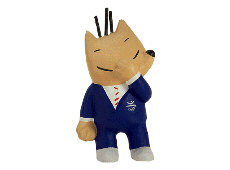 Cobi - Barcelona 1992 Cobi - Barcelona 1992Cobi - Barcelona 1992 The Spaniards did not immediately take to "Cobi", the surreal dog from the Summer Olympic Games of Barcelona, who was designed by local cartoonist Javier Mariscal. "Cobi's" popularity slowly grew and by the end of the Games he was loved universally by the Spanish and the rest of the world. "Cobi" was supported by a group of mascots during the Barcelona Games. The whole mascot crew was featured as part of a popular Spanish TV show. 科比,1992年巴塞罗那奥运会吉祥物,由西班牙漫画家扎维尔-玛瑞斯克设计。一开始并未被普遍接受,但随着奥运会的进程,科比开始流行起来,受到了西班牙人和全世界的喜爱。西班牙的电视台甚至制作了一套以奥运吉祥物为主角的电视剧集。 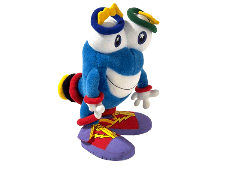 Izzy - Atlanta 1996 Izzy - Atlanta 1996Izzy - Atlanta 1996 The mascot of the 1996 Summer Olympic Games in Atlanta was an amorphous abstract fantasy figure. It carried the name "Izzy", derived from "Whatizit?" because no one seemed to know exactly what "Izzy" really was. He changed his appearance several times after the closing ceremony in Barcelona in 1992. Over time he grew a mouth where only lips had existed, he added stars in his eyes, bulked up and gained muscles in his previously spindly legs, and eventually sprouted a nose. 依奇,1996年亚特兰大奥运会吉祥物,是奥运史上第一个电脑设计的吉祥物。这个小怪物最初的名字叫"它是什么"(What is it?)。作为一个想象中的生物,依奇在巴塞罗那奥运会之后,曾几经改头换面。  Ollie, Syd and Millie - Sydney 2000 Ollie, Syd and Millie - Sydney 2000Ollie, Syd and Millie - Sydney 2000 "Ollie", a Kookaburra, "Syd", a Platypus; and "Millie", an Echidna, are three native animals chosen as mascots for the Sydney 2000 Games. These Australian animals represent the earth, air and water. "Ollie": epitomises the Olympic spirit of generosity and universal generosity (from Olympic). "Syd": represents the environment and captures the vigour and energy of Australia and its people (from Sydney). "Millie": is a techno-whiz and information guru, with all the facts and figures at her fingertips (from Millennium). The Organising Committee received hundreds of submissions from artists, children and others from around the world. Matthew Hatton's design was chosen to represent the Olympic mascots for the forthcoming millennium. 澳利、悉德、米利,2000年悉尼奥运会吉祥物。它们是三个澳洲本土动物,分别代表土地、空气和水。澳利代表了奥林匹克的博大精深;悉德表现了澳洲和澳洲人民的精神与活力;米利代表千禧年。奥组委当年曾收到来自全世界的数以万计的设计方案,最终选定了马修-哈顿的设计。 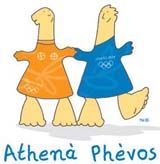 Phevos and Athena - Athens 2004 Phevos and Athena - Athens 2004Phevos and Athena - Athens 2004 Phevos and Athena, the official Athens 2004 mascots, are brother and sister. Their creation was inspired by an ancient Greek doll and their names are linked to Ancient Greece, yet the two siblings are children of modern times. The names are of two Olympian gods: Phevos, the god of light and music, known as Apollo; and Athena, goddess of wisdom and patron of the city of Athens. Phevos and Athena represent the link between Greek history and the modern Olympic Games. 雅典娜和费沃斯,2004年雅典奥运会吉祥物。它们是两兄妹,根据古希腊陶土雕塑玩偶为原型设计,名字暗含雅典。雅典娜是智慧女神,费沃斯是光明与音乐之神,他们代表了古典奥林匹克精神和现代文明的完美结合。 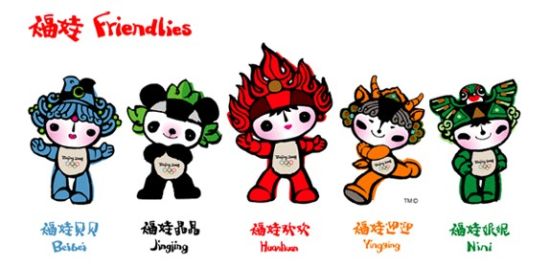 2008年北京奥运会吉祥物——“福娃”。 2008年北京奥运会吉祥物——“福娃”。2008年北京奥运会吉祥物——“福娃”。 这次奥运会的吉祥物形象是有史以来最多的,共有5个福娃,它们分别以“鱼、熊猫、奥运圣火、藏羚羊、京燕”为创意,被亲切地叫做“贝贝、晶晶、欢欢、迎迎,妮妮”。这组形象可爱、活泼的吉祥物,以“北京欢迎你”的谐音命名,将北京的祝福、中国的祝福带给世界。 Like the Five Olympic Rings from which they draw their color and inspiration, the Five Friendlies will serve as the Official Mascots of Beijing 2008 Olympic Games, carrying a message of friendship and peace--and blessings from China--to children all over the world. Designed to express the playful qualities of five little children who form an intimate circle of friends, the Five Friendlies also embody the natural characteristics of four of China's most popular animals--the Fish, the Panda, the Tibetan Antelope, the Swallow--and the Olympic Flame. Each of the Friendlies has a rhyming two-syllable name--a traditional way of expressing affection for children in China. Beibei is the Fish, Jingjing is the Panda, Huanhuan is the Olympic Flame, Yingying is the Tibetan Antelope and Nini is the Swallow. When you put their names together--Bei Jing Huan Ying Ni--they say "Welcome to Beijing," offering a warm invitation that reflects the mission of the Five Friendlies as young ambassadors for the Olympic Games. 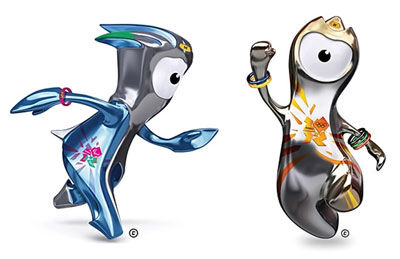 Wenlock - London 2012 Wenlock - London 2012Wenlock - London 2012 Wenlock was created from the last drop of British steel used for the London 2012 Olympic Stadium. That‟s why he is so shiny. His name is inspired by Much Wenlock in Shropshire, a town where "Much Wenlock Games" were held. The light on his head is inspired by the lights on London‟s iconic black taxis. The shape of the front of his head is identical to the shape of the Olympic Stadium roof. His eye is a camera lens, capturing everything he sees. The three points on his head represent the places on the podium where successful athletes stand to receive their medals. 2012年伦敦奥运会的吉祥物文洛克,使用名字来源于马齐-文洛克的施罗普希尔村。在那里,曾经举办过文洛克奥林匹克运动会。而这项古老的赛事正是现代奥运之父顾拜旦创造现代奥林匹克运动会的灵感来源地之一。为了纪念文洛克奥林匹克运动会,伦敦奥运会决定将吉祥物命名为“文洛克”。 文洛克头上的黄灯代表了具有标志性意义的伦敦出租车,而手上则戴着代表友谊的奥林匹克手链。 网友评论
|
||||||||||||||||




